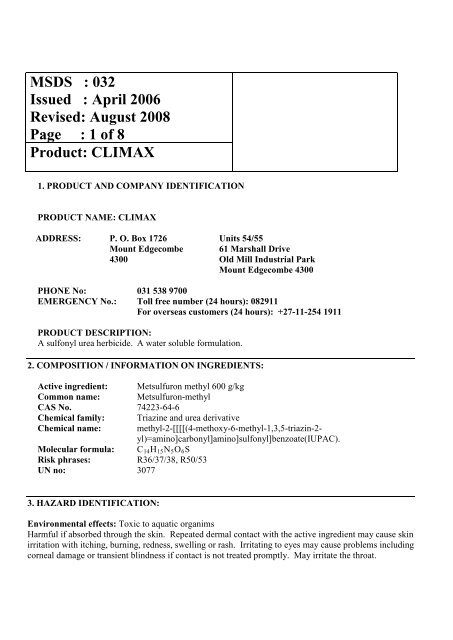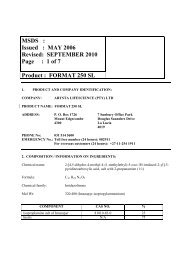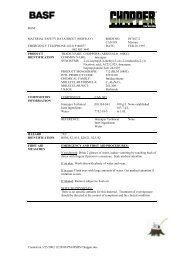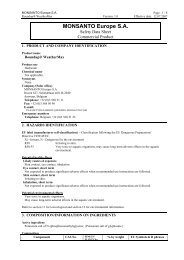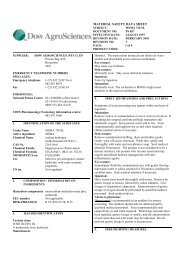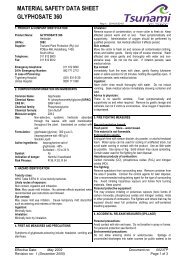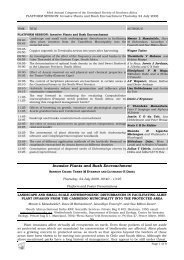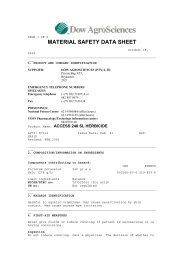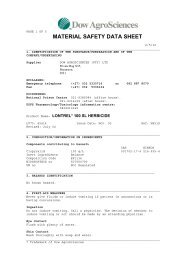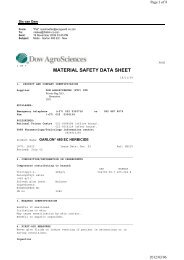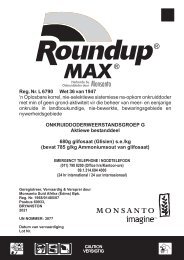MSDS : - Bush Encroachment
MSDS : - Bush Encroachment
MSDS : - Bush Encroachment
Create successful ePaper yourself
Turn your PDF publications into a flip-book with our unique Google optimized e-Paper software.
<strong>MSDS</strong> : 032<br />
Issued : April 2006<br />
Revised: August 2008<br />
Page : 1 of 8<br />
Product: CLIMAX<br />
1. PRODUCT AND COMPANY IDENTIFICATION<br />
PRODUCT NAME: CLIMAX<br />
ADDRESS: P. O. Box 1726 Units 54/55<br />
Mount Edgecombe 61 Marshall Drive<br />
4300 Old Mill Industrial Park<br />
Mount Edgecombe 4300<br />
PHONE No: 031 538 9700<br />
EMERGENCY No.: Toll free number (24 hours): 082911<br />
For overseas customers (24 hours): +27-11-254 1911<br />
PRODUCT DESCRIPTION:<br />
A sulfonyl urea herbicide. A water soluble formulation.<br />
2. COMPOSITION / INFORMATION ON INGREDIENTS:<br />
Active ingredient: Metsulfuron methyl 600 g/kg<br />
Common name: Metsulfuron-methyl<br />
CAS No. 74223-64-6<br />
Chemical family: Triazine and urea derivative<br />
Chemical name: methyl-2-[[[[(4-methoxy-6-methyl-1,3,5-triazin-2-<br />
yl)=amino]carbonyl]amino]sulfonyl]benzoate(IUPAC).<br />
Molecular formula: C 14 H 15 N 5 O 6 S<br />
Risk phrases: R36/37/38, R50/53<br />
UN no: 3077<br />
3. HAZARD IDENTIFICATION:<br />
Environmental effects: Toxic to aquatic organims<br />
Harmful if absorbed through the skin. Repeated dermal contact with the active ingredient may cause skin<br />
irritation with itching, burning, redness, swelling or rash. Irritating to eyes may cause problems including<br />
corneal damage or transient blindness if contact is not treated promptly. May irritate the throat.
<strong>MSDS</strong> : 032<br />
Issued : April 2006<br />
Revised: August 2008<br />
Page : 2 of 8<br />
4. FIRST-AID MEASURES:<br />
Inhalation:<br />
Skin contact:<br />
Eye contact:<br />
Ingestion:<br />
Remove patient from exposure, keep warm and at rest.<br />
Obtain medical attention as a precaution.<br />
Take off immediately all contaminated clothing.<br />
Wash skin immediately with cold water, followed by soap and<br />
water.<br />
Such action is essential to minimize contact with the skin.<br />
Contaminated clothing should be washed before re-use.<br />
Immediately irrigate with eyewash solution or clean water, holding<br />
the eyelids apart, for at least 15 minutes. Obtain immediate medical<br />
attention.<br />
If swallowed immediately give two glasses of water and induce<br />
vomiting.<br />
Seek medical advice immediately in cases of significant exposure.<br />
Note to physician:<br />
There is no antidote. Symptomatic treatment and supportive therapy as indicated.<br />
5. FIRE-FIGHTING MEASURES:<br />
Dust particles might form explosive mixtures in air, which may be ignited by open flame.<br />
Keep fire exposed containers cool by spraying with water.<br />
Extinguishing Media:<br />
For small fires, use foam, carbon dioxide, dry powder or halon extinguishant. For large fires, use foam or<br />
water-fog; avoid use of water jet. Contain run-off water with, for example, temporary earth barriers.<br />
Control runoff.<br />
Fire Fighting Protective Equipment:<br />
A self contained breathing apparatus and suitable protective clothing should be worn in fire conditions.<br />
6. ACCIDENTAL RELEASE MEASURES:<br />
Ensure suitable personal protection during removal of spillage. This means wearing a face mask<br />
that gives protection against organic dusts, eye protection, chemically resistant gloves, boots<br />
and coveralls. Cover spillage with damp sand, earth or any suitable adsorbent material. Transfer<br />
to a container for later disposal. If spill area is on ground near valuable plants or trees, remove top 5<br />
cm of soil after initial clean up. Place soil in containers for disposal. Spillage or uncontrolled<br />
discharges into water courses must be alerted to the Department of Water Affairs/Environment.
<strong>MSDS</strong> : 032<br />
Issued : April 2006<br />
Revised: August 2008<br />
Page : 3 of 8<br />
7. HANDLING AND STORAGE:<br />
HANDLING:<br />
Read the label before use. Avoid contact with skin and eyes. When using do not eat, drink or<br />
smoke. Wash face and hands before eating, drinking or smoking.<br />
STORAGE:<br />
Store under lock and key. Keep in original container, tightly sealed.<br />
Store in a cool, dry place away from sources of heat and naked flames.<br />
Store away from farm feeds and food stuff.<br />
8. EXPOSURE CONTROL / PERSONAL PROTECTION:<br />
Engineering controls:<br />
Use only with adequate ventilation. .In industrial situation, concentration values below the TWA value should be<br />
maintained. Values may be reduced by process modification, use of local exhaust ventilation, capturing<br />
substances a the source, or other methods. If you believe airborne concentrations of mists, dusts or vapours<br />
are high you are advised to modify the process of environment to reduce the problem.<br />
Personal protection:<br />
Respiratory protection:<br />
Do not inhale dust. A face mask or respirator should be used when the product is being used.<br />
Protective gloves:<br />
Rubber, PVC or other protective gloves should be used other than for brief use. Failure to use gloves may<br />
result in skin irritation and symptoms ranging from redness and itching to blisters and even burns.<br />
Eye protection:<br />
Goggles or full face shield must be used when using this product. Failure to do so may result in eye damage<br />
if an accident occurs.<br />
Clothing:<br />
Wear long-sleeved shirt and long pants. Clean overalls should be worn, preferably with an apron. All skin<br />
areas must be covered.<br />
Safety boots:<br />
Wear safety boots with socks.
<strong>MSDS</strong> : 032<br />
Issued : April 2006<br />
Revised: August 2008<br />
Page : 4 of 8<br />
9. PHYSICAL AND CHEMICAL PROPERTIES:<br />
Appearance<br />
: free flowing powder<br />
Color<br />
: tan<br />
Odor<br />
: odourless<br />
Density ( g/ml) : 530 –680 kg/m 3<br />
Self ignition Temp : 425ºC<br />
Solubility (g/l)<br />
: dispersible<br />
Corrosiveness<br />
: not corrosive<br />
10. STABILITY AND REACTIVITY:<br />
Hazardous decomposition Product(s):<br />
Combustion or thermal decomposition will evolve toxic and irritant vapours.<br />
Stable at normal temperatures and storage conditions.<br />
11. TOXICOLOGY INFORMATION:<br />
Oral LD 50 :<br />
> 5,000 mg/kg in rats.<br />
Dermal LD 50 rabbits: > 2,000 mg/kg,<br />
Inhalation LC 50 : (4 hours): 5 mg/l (rats).<br />
Skin irritation:<br />
May cause mild skin irritation.<br />
Skin sensitization: No skin sensitization has been observed in guinea pigs<br />
Eye irritation:<br />
Moderate but reversible eye irritation has been seen in rabbits.<br />
Reproductive Effects:<br />
Multigeneration studies in rats did not result in any reproductive effects at the<br />
highest doses tested of 250<br />
mg/kg/day.<br />
Teratogenic Effects: Metsulfuron-methyl did not cause developmental abnormalities to offspring of rats<br />
and rabbits fed 1000 mg/kg/day and 700 mg/kg/day respectively during gestation.<br />
These doses represent the highest dose tested for each experiment.<br />
Carcinogenic Effects: Negative for rats and mice in laboratory tests, but studies may not have been at<br />
maximum tolerated dose .<br />
Mutagenic Effects: The weight of evidence presented by a battery of tests to measure mutagenicity and<br />
other adverse effects on DNA indicates that metsulfuron-methyl is neither<br />
mutagenic nor genotoxic
<strong>MSDS</strong> : 032<br />
Issued : April 2006<br />
Revised: August 2008<br />
Page : 5 of 8<br />
12. ECOLOGICAL INFORMATION:<br />
Birds:<br />
Metsulfuron-methyl has very low avian toxicity.<br />
Acute oral LD 50 for mallard ducks >2510 mg/kg<br />
Fish:<br />
The chemical has very low toxicity to aquatic organisms.<br />
LC 50 (rainbow trout)(96 hours): 380 mg/l<br />
Daphnia:<br />
LC 50 (48 H) >150 mg/l<br />
AlgaeEC 50 -72h: 0,157 mg/l. Toxic to algae.<br />
Lemna gibba: Toxic to Lemna 0,36 µg/l.<br />
Bees:<br />
Metsulfuron-methyl has low acute toxicity to honey bees with a topical LD 50 of greater than 25 µg/bee<br />
Earth Worms: > 1000 mg/kg.<br />
Soil persistence:<br />
The breakdown of metsulfuron-methyl in soils is largely dependant on soil temperature, moisture content,<br />
and pH.<br />
Half-life estimates for metsulfuron-methyl in soil are wide ranging from 14 - 180 days, with an overall<br />
average of reported values of 30 days.<br />
Mobility:<br />
The chemical has a higher mobility potential in alkaline soils than in acidic soils, as it is more soluble<br />
under alkaline conditions.<br />
Surface water:<br />
Metsulfuron-methyl is stable to photolysis, but will break down in ultraviolet light.<br />
The chemical is stable to hydrolysis at neutral and alkaline pHs, and has a half-life of 3 weeks at pH 5.0
<strong>MSDS</strong> : 032<br />
Issued : April 2006<br />
Revised: August 2008<br />
Page : 6 of 8<br />
13. DISPOSAL CONSIDERATIONS:<br />
Do not contaminate rivers, dams or any other water source with chemical or used containers.<br />
Drain and triple rinse containers and then destroy by perforation and flattening.<br />
Bury in an approved landfill site.<br />
Do not re-use containers for any other purpose.<br />
14. TRANSPORT INFORMATION:<br />
UN NUMBER: 3077<br />
ADR/IRD:<br />
Proper shipping name: Environmentally hazardous substance, solid, n.o.s.<br />
(Metsulfuron-methyl)<br />
Class: 9<br />
Classification code: M 7<br />
Hazard ID: 90<br />
Packaging group: III<br />
IMG/IMO:.<br />
Proper shipping name: Environmentally hazardous substance, solid, n.o.s.<br />
(Metsulfuron-methyl)<br />
Class: 9<br />
Label:<br />
9. Marine pollutant<br />
Packaging group: III<br />
AIR/IATA :<br />
Proper shipping name: Environmentally hazardous substance, solid, n.o.s.<br />
(Metsulfuron-methyl)<br />
Class: 9<br />
Packaging group:<br />
Passenger aircraft:<br />
Cargo aircraft:<br />
Tremcard No:<br />
III<br />
Y911 (30Kg)<br />
900 (No limit)<br />
90GM7-III
<strong>MSDS</strong> : 032<br />
Issued : April 2006<br />
Revised: August 2008<br />
Page : 7 of 8<br />
15. REGULATORY INFORMATION:<br />
Hazard symbol: N<br />
Indication of danger: Dangerous to the environment.<br />
Risk phrases:<br />
R36/37/38 Irritating to eyes, respiratory system and skin.<br />
R50/53 Very toxic to aquatic organisms, may cause long-term adverse effects in the<br />
aquatic environment.<br />
Safety phrases:<br />
S(1/2)<br />
Keep locked up and out of reach of children.<br />
S3/7/9<br />
Keep container tightly closed in a cool, well ventilated place.<br />
S20/21 When using do not eat, drink or smoke.<br />
S24/25 Avoid contact with skin and eyes.<br />
S60<br />
This material and its container must be disposed of as hazardous waste.<br />
S61<br />
Avoid release to the environment. Refer to special instructions/Safety data shee<br />
16. OTHER INFORMATION:<br />
References:<br />
• Similar product <strong>MSDS</strong>.<br />
• The Pesticide Manual; Thirteenth Edition; Editor Clive Tomlin; Crop Protection<br />
Publications, 2003.<br />
• ADR, Vol.1, applicable January 2005.<br />
• Dangerous Goods Regulations; IATA International Air Transport Association, 46 th<br />
Edition, Effective 1 January 2005.<br />
• IMDG Code, Vol. 2, 2004 Edition.<br />
• EXTOXNET, Pesticide Information Profiles, Revised June 1996. The primary files are<br />
maintained and archived at the Oregon State University.<br />
• ECB-ESIS<br />
Read the label before use or buy.<br />
Use pesticides safely.<br />
The data in this Material Safety Data Sheet relates only to the specific material designated herein<br />
and does not relate to use in combination with any other material or in any process. All
<strong>MSDS</strong> : 032<br />
Issued : April 2006<br />
Revised: August 2008<br />
Page : 8 of 8<br />
________________________________________________________________________________<br />
OTHER INFORMATION (Contd.):<br />
information is given in good faith but without guarantee in respect of accuracy, and no<br />
responsibility is accepted for errors or omissions or the consequence thereof.<br />
Usage : A sulfonyl urea herbicide.<br />
CLIMAX is the property of VOLCANO AGROSCIENCE (Pty) Ltd.<br />
END OF DOCUMENT.


